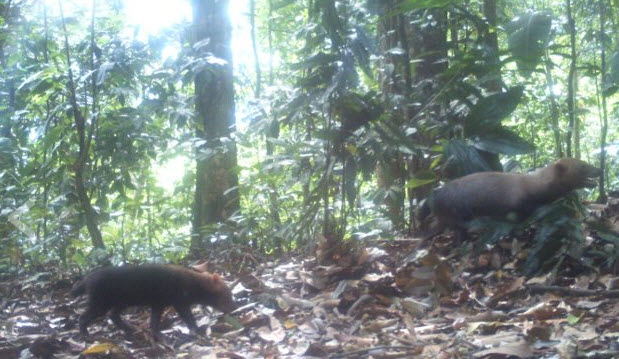A little-seen canid from Central and South America, whose precise distribution remains just as elusive, has popped up in a camera trap study.
The animal in question is the bush dog (Speothos venaticus), a 1-foot-tall (at the shoulder) creature that runs in packs of up to 10 and lives primarily in tropical forests.
Its diet consists mainly of rodents, with the occasional armadillo thrown into the mix.
Its population distribution, meanwhile, remains something of an unsettled question. The International Union for Conservation of Nature (IUCN) considers the animal’s range to be widespread, from extreme eastern Central America and northern South America south to Paraguay and northeastern Argentina.
But the IUCN also terms the creature “naturally rare” throughout that area. “The species has proven to be extremely difficult to locate in the wild, making estimates of population trends difficult,” according to the organization.
For now, the IUCN’s “red list” of threatened species classifies bush dogs as “near threatened.”
Automated camera traps in remote portions of Panama caught the rare sighting. The cameras were being used by Smithsonian Tropical Research Institute (STRI) researchers as part of a broader study on large mammals, such as Jaguars, when the reclusive creatures appeared.
Now a new study in the journal Canid Biology & Conservation documents the bush dogs’ appearance on camera.
“The bush dog is one of the rarest species that we photograph,” said study co-author Ricardo Moreno, of the STRI, in a release.
Indeed, the scientists said bush dogs appeared before the cameras on just 11 days out of a total of 32,000 camera days (the number of cameras used in the study multiplied by the number of days in use).
The researchers said at least one part of the bush dog’s distribution can be confirmed: Panama.
“Camera-trap photos taken for the first time in Panama in 2012 and 2015,” the authors wrote in their study, “together with the new sightings, confirm the species’ broad and continuous distribution along the Panamanian Isthmus.”
While Panama is the only country in Central America where the species is known to occur, “we think that it will soon cross the border into Costa Rica,” Moreno said.
Moreno and his co-authors suggest stronger measures be undertaken going forward to accurately assess population trends for bush dogs in Panama, as “rapid depletion of forest habitat and the decline of prey species” may make things difficult for the small canids in the region.
